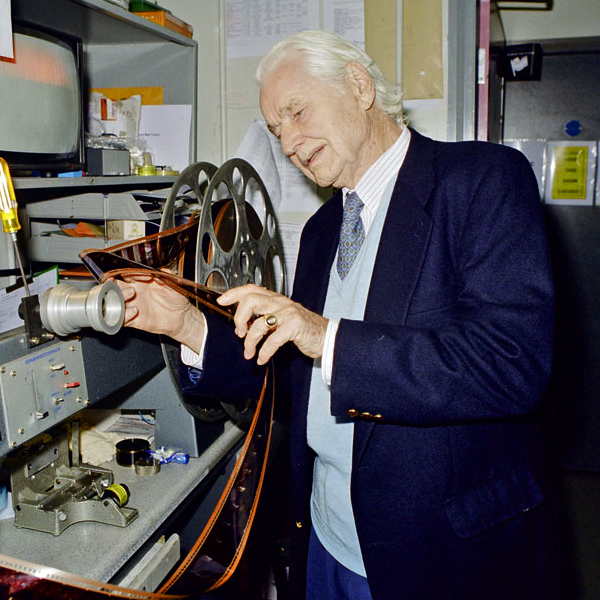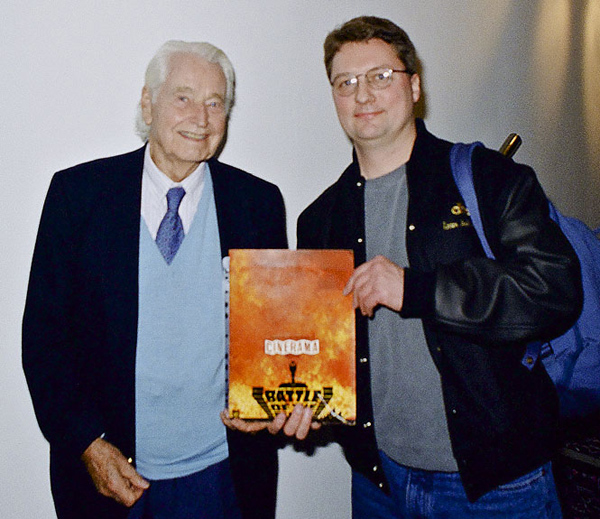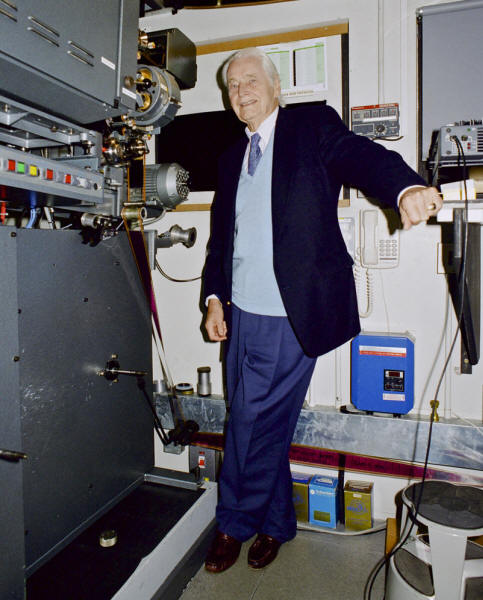Uddrag af Interview med filminstruktør Ken Annakin om "Panserslaget ved Ardennerne" i Ultra Panavision 70 |
Tilbage til
forsiden |
| Interviewet i Bradford, UK, 11. marts 2000 af: Thomas Hauerslev. Se fuldt interview på in70mm.com | Dato: 16.04.2022 |
 Ken
Annakin inspicerer 70mm kopi af "Panserslaget ved Ardennerne" ved
spolebordet i Pictureville biografen i Bradford (UK) marts 2000. Foto:
Thomas Hauerslev Ken
Annakin inspicerer 70mm kopi af "Panserslaget ved Ardennerne" ved
spolebordet i Pictureville biografen i Bradford (UK) marts 2000. Foto:
Thomas HauerslevThomas Hauerslev: Tell me about the circumstances for choosing Ultra Panavision 70 for "Battle of the Bulge". Ken Annakin: On "Battle of the Bulge" I did not have the choice of the system, but one of the things that helped me decide me to make this movie was the chance to show tanks looking like monsters, coming out of the ground and towering over the puny, small "human insects". Then, of course, I had to show how the human beings actually win the battle. That was my concept and I could only achieve it on a system like Ultra Panavision 70. • Gå til Se "Panserslaget" i 70mm den 1. maj 2022 • Gå til Bag om "Panserslaget ved Ardennerne" THa: You were saying "God was with you on "Battle of the Bulge""? What did you mean by that? Ken Annakin: The first day of shooting, when the whole armada of Shaw's tanks came out from under the trees, we had prepared the ground to look snow covered, with marble dust. And we had four big wind machines behind my camera ready to blow snow all over the foreground. I gave the signal to start and Alex Weldon, my special effects guy started up his snow machines. As the tanks rolled out, the snow looked great, so I gave him the "thumbs up" sign, meaning "Great!" He looked at me - we couldn't hear each other because of the noise, and shook his head. Then he pointed upward, his lips mouthing "Not me - HIM". He meant that God was making the snow, and it continued to snow for 6 solid weeks. We often had to walk two miles to the locations, and the tanks spun round and threw up mud in the snow. Believe it or not, I had 80 regular tanks from the Spanish army under my command. They passed perfectly for the German tanks used in the battle at this time...and I turned them into monsters! After the six weeks, the producer Philip Yordan showed me a cable he had just received from Jack Warner in Hollywood. It said:
This obviously gave me and
my crew a great shot in the arm. |
Læs
mere her: Bag om "Panserslaget ved Ardennerne" i Ultra Panavision 70 Se "Panserslaget" i Gentofte Kino, 1. maj 2022: 7OMM Filmfestival in70mm.com: Ken Annakin (DE) in70mm.com: Ken Annakin (UK) Sensationel Todd-AO Forestilling i Malmø "Disse Fantastiske Mænd i Deres Flyvende Maskiner..." den 16. marts 2013 Historien om 70mm Film i Danmark Danmarks 70mm og Storformat Biografer Film- og Kinoteknik Mine damer og herrer, "Dette er Cinerama"! Hvad CinemaScope Byder på Todd-AO, - det sensationelle filmsystem Hvad er VistaVision? Biografmuseets biografhistoriske kalender. Vigtige datoer og begivenheder i biografhistorien |
 Ken
Annakin med 70mm film fan i Pictureville biografen i Bradford (UK) marts
2000. Foto: Francois Carrin Ken
Annakin med 70mm film fan i Pictureville biografen i Bradford (UK) marts
2000. Foto: Francois CarrinTHa: Can you remember why Cinerama was brought into "Battle of the Bulge"? Ken Annakin: Around this time the Producers began to realize that they weren't going to have enough money to finish the film on the scale we were shooting. Suddenly a Guardian Angel appeared in the form of William R. Forman, who owned Cinerama. I think he had been shown my tank footage by Jack Warner, and he said,
He came over to
Segovia with a special Cinerama Cameraman, George Willoughby. After
discussions, we made arrangements for him to cover quite a few shots of tank
movement from the air, plus downhill car shots, which almost had a 3D
effect. For our part we carried on shooting with our Panavision cameras, and
eventually printed everything in Cinerama process and format. Obviously it
all worked!! I remember we premiered in the Cinerama theatre [Hollywood, ed].
And Forman's girl friend led 500 troops down the boulevard before the show
started.
Shaw was adamant. Eventually, Forman said,
I eventually said to Shaw
Most reluctantly, Shaw agreed
and we overcame the crisis. Barbara didn't become a great movie star, but
Forman was able to keep his promise. |
|
 Ken
Annakin poserer med en Victoria 8 70mm maskine i Pictureville biografen.
Filminstruktør Ken Annakin var æresgæst under Widescreen Weekend i 2000 i
Bradford, UK. Picture by Thomas Hauerslev Ken
Annakin poserer med en Victoria 8 70mm maskine i Pictureville biografen.
Filminstruktør Ken Annakin var æresgæst under Widescreen Weekend i 2000 i
Bradford, UK. Picture by Thomas HauerslevTHa: Tell me about sound recording on the set. Ken Annakin: I don't recall it made any difference except that the mike had to be hung higher to stay out of picture. We recorded all sound for "Flying Machines" and "Battle of the Bulge" on location as we filmed. I'm sure it is likely that a lot of post syncing was done afterwards in the studio. It's a strange thing nowadays to read about Directors who are expected to go through every step of Post Production. In the days that I was making these big movies, I rarely went through more than one stage. You completed your final Director's cut and then it went into the Studio Post Production "machine", and they did all the rest of the work. Certainly on "Flying Machines" I was very much involved with the music, but didn't take part in the final dub, nor on "Longest Day" or "Battle of the Bulge". On the latter as I have said we had almost run out of money, so much so, that I first was asked to edit my final battle scenes personally with just the help of a Spanish assistant. I hadn't been editing myself for quite some years but I enjoyed doing that and it looked excellent. It remained to have the tank special miniatures filmed by Eugène Lourié, our special effects guy. I never saw the film again until the premiere in Hollywood. Philip Yordan met me with a rather guilty look in the foyer and said
That taught me that in such a
situation you must always make a personal dupe of your work, so that if
anyone plays around with it, you can put it back again. There is always some
kind of lesson you learn on every film. |
|
|
Gå:
tilbage
- op Opdateret onsdag, 28 maj 2025 17:41:04 |
|

